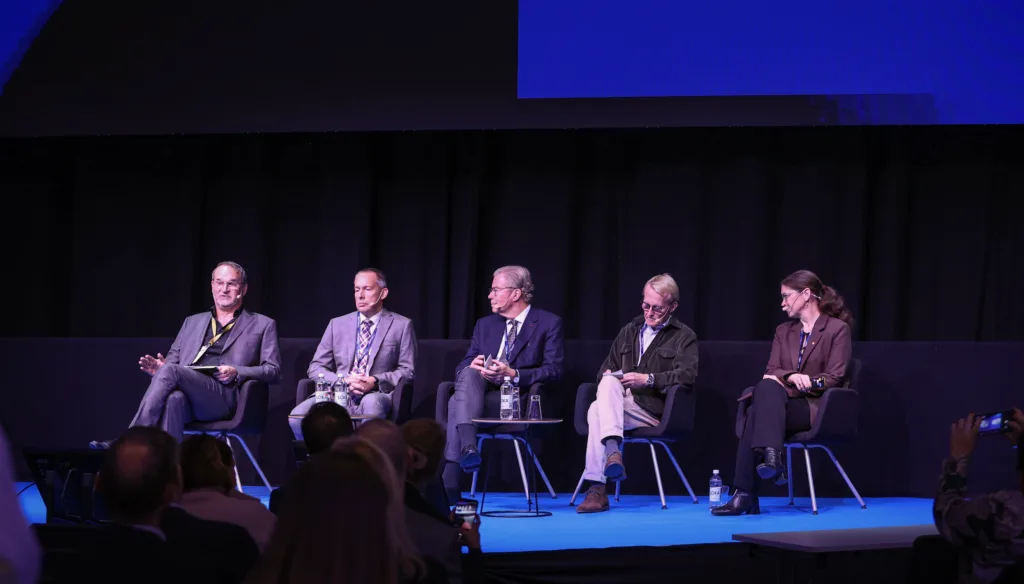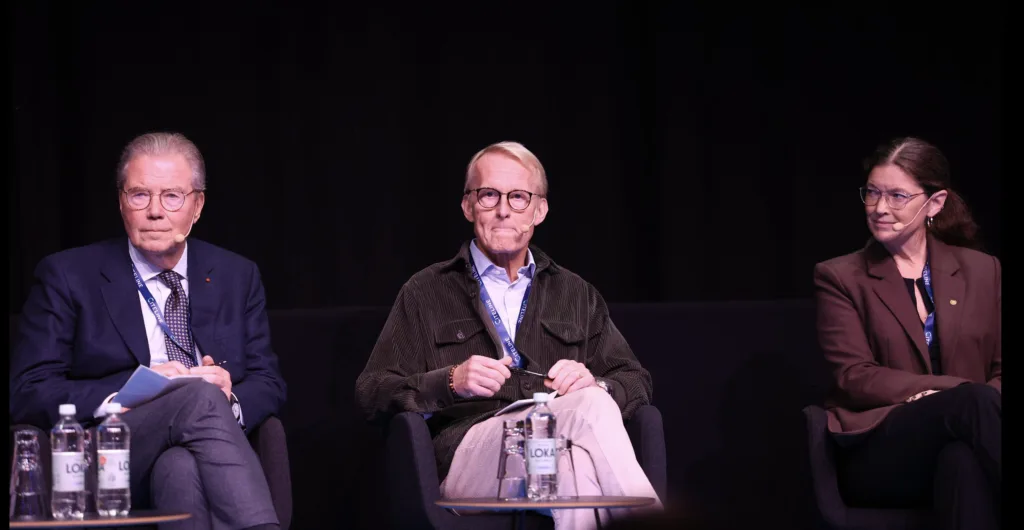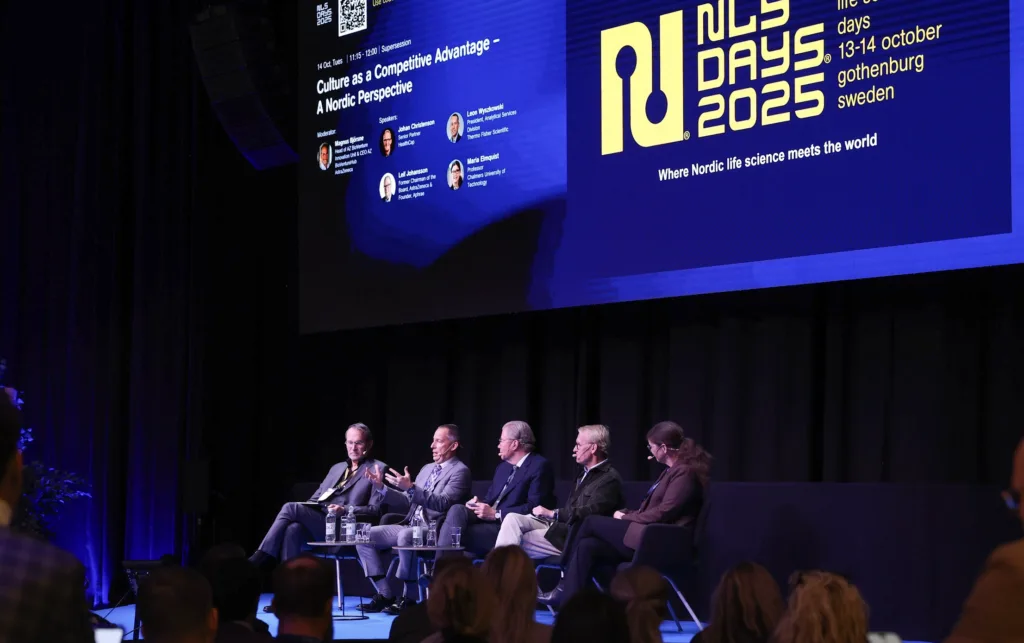Culture as a Competitive Advantage – A Nordic Perspective

By Scius Communications
Culture eats strategy for breakfast! That’s a bold saying, highlighted by AstraZeneca’s former Chairman of the Board, Leif Johansson, to set the scene for a wide-ranging NLSDays panel discussing how national and particularly organisational culture plays a key role in shaping innovation capacity.
The panel was moderated by AstraZeneca’s Magnus Björsne, who is CEO of the company’s BioVentureHub, an open innovation platform offering an inside track to AstraZeneca’s scientific expertise, world-class infrastructure, and facilities. The highly important topic was in fact initiated by the moderator and co-developed with the panelists and organizers to share experiences demonstrating why culture is a competitive advantage and a strategic priority for industry leadership.
The panel included perspectives from individuals with insights into the Nordic ecosystem, including HealthCap’s Johan Christenson, Professor Maria Elmquist from Chalmers University of Technology, and Thermo Fisher Scientific’s Leon Wyszkowski.
Culture is not something that normally gets talked about at partnering events like these, but it is often said that what a company achieves is unique and hard to replicate as it’s driven by its culture. Some places, such as the Nordics, can argue, politely, that what they have culturally is in some way special, and worth exploring to see how culture can power innovation and cross borders, such as the Ikea brand. Culture is not just background noise: it is a living asset.
To help set the scene for a fruitful discussion about the subject, local Professor Maria Elmquist, from Chalmers University of Technology, explained a well-established framework breaking cultural factors down into six dimensions, which include ‘power distance’, ‘individualism’ and ‘uncertainty avoidance’. This was done by Dutch social psychologist Geert Hofstedeto help understand international differences in work related values and how those can influence innovation.

Social trust as a key ingredient
In the Nordics, which are consistently top-ranked in global innovation indices, important variables within Hofstede’s framework are that there is a strong social trust in society. When people feel ‘psychological safety’ they feel empowered to step forward and propose new ideas. Equally, the Nordics are strong on equality, wanting people to be treated positively, and generally being more open to change, and respecting a strong work-life balance. That said, a consensus driven organisation may struggle with fast decision making. Cultures have different traditional frameworks for getting things done, and it is said that Sweden’s consensus driven approach can be a little slow on making big decisions. And then, when a decision is finally made, there can be fear of failure, and having made the wrong decision. In the US, good CEOs can be kicked out of their job several times, as the cultural norm is to consider this a valuable learning experience. In Sweden, you probably wouldn’t get to see another company breakfast.
The panel agreed it is important to differentiate between National and organisational culture, as a global company with offices in many countries will need to establish an overall organisational culture and a company strategy, vision and values that can be integrated and shared across all its employees. The organisational culture needs to be aligned to the company strategy to enable innovation but also effective decision making and execution. As Leif emphasised, execution is what matters, especially when it comes to selling medicines and saving lives. National culture can oil the wheels of industry and organisational culture influences the decisions to make, so a company’s internal culture really matters to be able to execute well. Corporate culture is a leadership responsibility, or as Leif neatly put it, “The culture in this Company is my next boss.’

A competitive advantage?
But can culture be a competitive advantage in the long term? As the long term is just a series of short-terms one after another, near-term performance cannot be ignored at the expense of the future-orientedvision and mission. Short term poor performance needs to be addressed to ensure success in the longer term.
Chiming in, Johan Christenson, Senior Partner at HealthCap, talked on how capital plays a key role in fuelling innovation and creating value. But if it was just simply a matter of throwing more money at a problem to solve it, life would be easy, but it is demonstrably not. A shared vision and a restrained budget drives people to be very focused.
Within a large organisation, having a handful of core values as Thermo Fisher does with its ‘4i’ framework, covering ‘integrity, intensity, innovation, and involvement’, can help align employees around the desired culture. Leif observed that at AstraZeneca, in a time when the company’s share price was taking a beating due to its inability to kill internal projects, the leadership established a more formal and brutal project evaluation framework known as the ‘5R’s’. The company also dispensed with any unhealthy preoccupancy with the ‘not invented here’ syndrome to encourage people to become more externally facing and collaborative with industry, which one could argue is a cultural trait that just needed to be mobilised. Now, around 50% of AstraZeneca’s pipeline is fuelled by collaborations and innovation, which have enabled it to access the most cutting-edge innovation, externally as well as internally.
Leon observed that Swedes are very humble and get a lot done without bragging about it. Who hasn’t heard Americans shout loud and proud about Boston, and Kendall Square as the world’s best biotech hub? Yet when you put the Nordics under the lens of the ‘culture’ microscope there’s a lot going for the geography: a stable regulatory environment, smooth supply chains, a lot of home-grown talent, and the ability to attract demand for products and services. But many places have that, so culture can act as a differentiator – where do you feel comfortable? Are people up for collaborating? Is it possible to feel a meaningful connection? And if a place does have all that, as the Nordics do, then that can positively influence the velocity and resilience of innovation.
The word ‘company’ itself derives from Latin with a cultural meaning of ‘one who eats bread with you’, or as the Swedes like to, enjoy a social ‘Fika’ moment together, connecting over coffee and cinnamon buns. Perhaps such social moments of connectivity and exchanging ideas play a role in a successful organisational culture? Culture may well eat strategy for breakfast, but it really needs a decent coffee afterwards to seize the day.